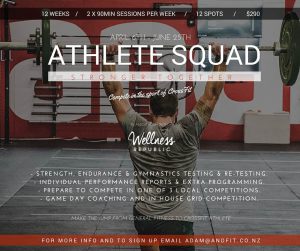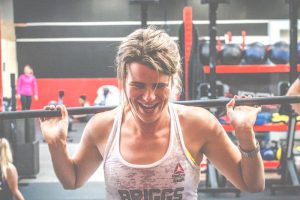With that in mind, why do we often see training programs piling workout upon workout for a 90 minute to 2-hour training session? In reality these programs are not designed for those who simply want to get fit. They are designed for those who want to qualify for Regionals or for the overzealous “weekend competition warrior”. That’s not to say that volume doesn’t have its place. Firstly, volume is necessary for recovery adaptation, which in turn allows you to recover faster from workout intensity. In other words, at a local competition that may comprise of 4-5 workouts in one day, training volume allows you to recover better between each event and hit each of those 4-5 workouts with greater intensity.
Secondly, volume allows athletes to work on multiple areas of fitness in one session (providing intensity and/or quality can be maintained). However, as many of you know, volume comes at the cost of recovery. It becomes physically and mentally challenging to maintain intensity when volume is increased. Herein lies another benefit of volume, demanding intensity when you are physically and mentally fatigued teaches you how to perform when you are not fresh – for instance; on the final workout of a two-day competition.
Despite the potential benefits to increased training volume, mindlessly cramming workout upon workout in pursuit of fitness goals can end up stalling progress or invite injury. The most pig-headed athletes can compromise their recovery and eventually push themselves into the dreaded ‘overtraining’ zone, which often brings a regression in athletic performance. Increased volume demands more sleep, precise nutritional habits that support performance, an injury prevention routine (massage, chiropractic work, mobility, etc.) and good communication with a coach. It’s also important to ensure that volume does not come at the expense of intensity.
So, in theory volume can help athletes achieve success in CrossFit as a sport, but it should be implemented safely and systematically. This is absolutely something that should be discussed with your CrossFit coach before jumping into.
For affiliate owners looking to add more volume into their classes, it’s important to remember that the majority of your members and thus the majority of your income, comes from members who are training for life. A one-hour session four to five times a week which consists of a warm up, strength piece or skill work, conditioning, and a cool down will be more than enough to obtain fitness for life. Trying to cram more into a one-hour CrossFit class makes it more difficult to meet your member’s needs. Don’t forget these needs include correcting, cueing and improving their movement, not simply starting the clock and saying ‘3-2-1-GO’. As six time CrossFit Games athlete James Hobart says, “volume is not the cure-all; effective coaching is.”.
For athletes looking to add more volume into their training, it’s crucial that they have a base of mechanical proficiency in the foundational movements and they are consistent in their approach to intensity. If you struggle with basic mechanics in movements such as the squat or with overhead mobility, then volume isn’t the solution for you. Doing workout after workout is not a shortcut to fitness. If you lack good mechanics, it’s a shortcut to the reinforcement of poor movement. The more you practice poor movement the better you will get at poor movement. Top athletes strive for perfect mechanics in foundational movement and have an established training history that allow them to increase their training volume.
For most of us, intensity is where the magic happens. As games athlete and good friend Pat Barber would say, “find that dark place in a workout and push further until you find an even darker place.” Intensity reigns king in CrossFit and this is what separates CrossFit from the majority of other fitness programs. It’s what drives change and produces results. Volume can certainly be used to gain the upper hand in the sport of CrossFit but it should not be added at the cost of intensity. As a coach you should know what people in your gym train for. If it’s training for life, then there is no need for pure volume. This group will improve work capacity across broad time and modal domains with constantly varied functional movements executed at high intensity during once-a-day sessions, four to five times per week. Those who are looking to compete and have a solid base of mechanics as well as consistency and hit their workouts with high intensity, can then begin to look at a structured approach of increased volume in their training.
-Daniel Rankin (Head Coach, Andfit CrossFit)
References
Laursen, P. B. (2010). Training for intense exercise performance: high‐intensity or high‐volume training?. Scandinavian journal of medicine & science in sports, 20(s2), 1-10.
Gibala, M. J., Little, J. P., MacDonald, M. J., & Hawley, J. A. (2012). Physiological adaptations to low‐volume, high‐intensity interval training in health and disease. The Journal of physiology, 590(5), 1077-1084.
Hobart, J. (2016, March 18). A Deft Dose of Volume. Retrieved from http://journal.crossfit.com/2016/03/a-deft-dose-of-volume.tpl
]]>Athlete Squad Training Block (non andfit members welcome!)
—————————————
Coach Adam has put together an amazing 12 week program for CrossFitters interested in the Sport of CrossFit. Over the 24 sessions (2 x 90min sessions per week)
– STRENGTH, ENDURANCE & GYMNASTICS TESTING & RE-TESTING.
– INDIVIDUAL PERFORMANCE REPORTS & EXTRA PROGRAMMING.
– PREPARE TO COMPETE IN ONE OF 3 LOCAL COMPETITIONS.
– GAME DAY COACHING AND IN HOUSE GRID COMPETITION.
With the Open coming to an end, this is the perfect opportunity to get stuck in and target those weaknesses that the Open always expose. The 12 week Block is well timed with the Andfit 3’s on the 11th of June, the Wild West comp on the 18th of June and a in house GRID style comp that you can work towards if you are interested. For more information on the training block, to register or for payment options please email [email protected]
By Adam Billing. With intro from Nikki Petrou.
Have you ever noticed a child squat? How about an elderly Asian man enjoying a cigarette on a street corner? These squats are pieces of artistry; knees-out, straight-backed beautiful formations. Meanwhile we, mere mortals of the office-bound variety, can only dream of such lofty squat perfection. Some of us pour hours into mobility, and squat practice in the quest to achieve what comes effortlessly and naturally to a toddler.
In most traditional cultures around the world, lower back pain is almost non-existent, despite the fact that people living in these societies perform a lot more physical labour. The reason is clear most people in traditional societies rarely, if ever, sit in chairs for long periods of time. If they need to rest, they squat. Squatting is what your body was designed to do.
We are all born with the ability to perform a Chinese weightlifter’s perfect squat, then through exposure to the modern world we lose this ability. For me, 5 years working in the corporate world, sitting on a death pod (chair) certainly took away some of my ability to squat well. I’m now fighting every day to get it back through regular, unloaded squatting and mobility.
Recently I asked one of our members, who couldn’t perform an air squat when he first arrived (and is now squatting more than his body weight) if squatting had changed his life. He replied “Yes, to have that flexibility in my lower body is amazing!” – notice no mention of strength, gains or having massive thighs to show off this summer?
He’s absolutely correct too. Tight hips and low-back changes the way you walk and move in-general. Joints and muscles operate on a “move it or lose it” basis, meaning that they will slowly tighten and restrict range-of-motion over time when full joint range-of-motion isn’t used regularly. Full range of motion for your ankles, hips and knees is found at the bottom of a squat. Do you have trouble getting into a full squat (i.e. heels on the floor)? It’s because you don’t do it regularly enough. Move your body in the way it was intended.
Forget about squatting double body weight or going for that new PB this is a mobility issue and even if it doesn’t bother you now, it certainly will down the road after years of neglect.
So, let’s all rise from our chairs and bust out that sales report from the comfort of our anatomical chair. When people in the office look sideways at you just tell them “the Chinese do all their work like this, it makes you smarter!”.
I recently attended a conference where Nic Gil the All Blacks strength and conditioning coach said “If something’s important do it often”. So how about this, every time you walk into the gym you perform this handy little sequence from the master of movement Ido Portal and then just sit in the bottom of a squat for 3 minutes. https://youtu.be/xPwG2hqnOx0
I promise you, with as little as 2 – 3 minutes per day holding at the bottom of a squat you’ll be impressed with how much better your body can feel when it moves as it was intended.
]]>

